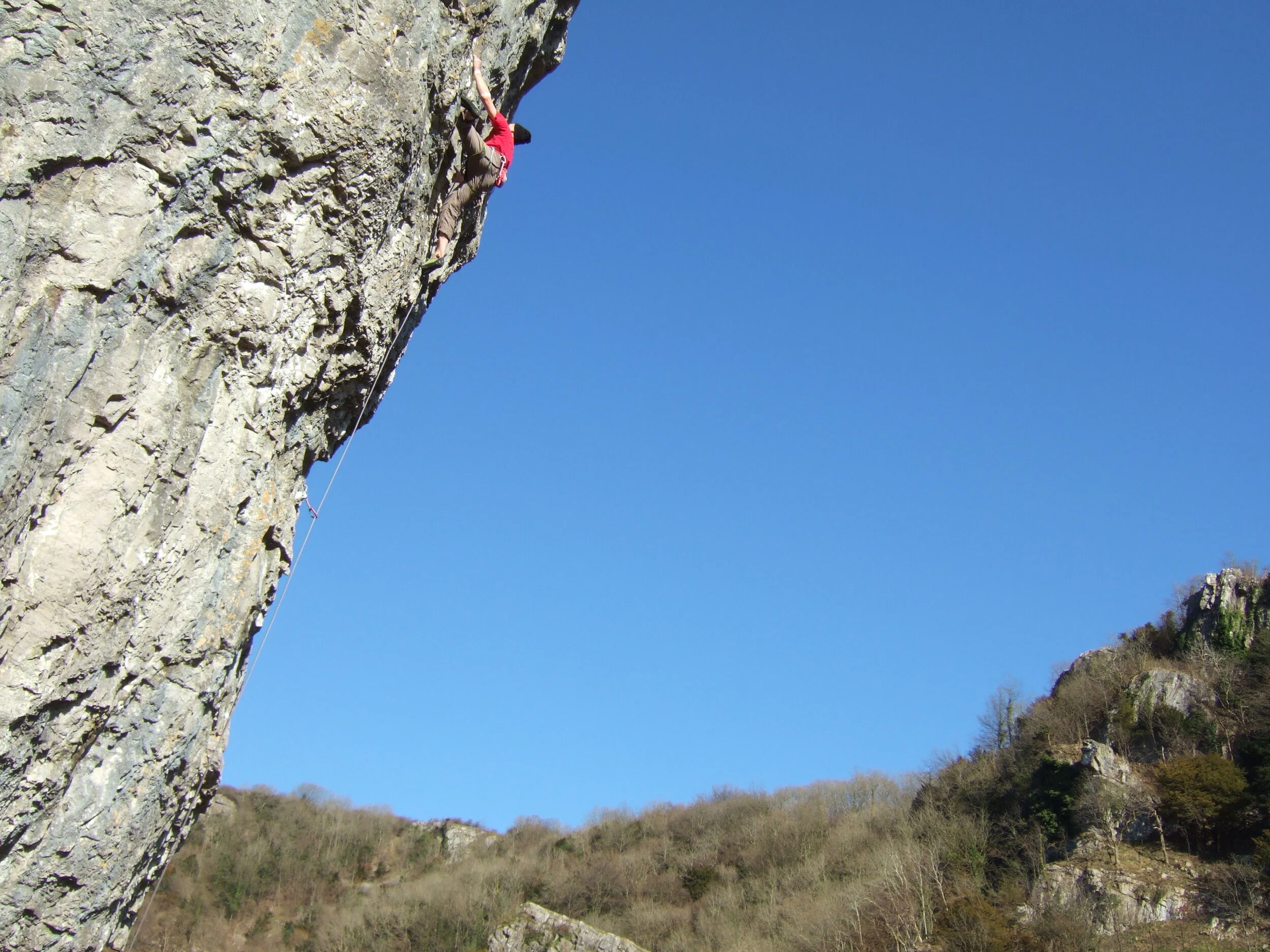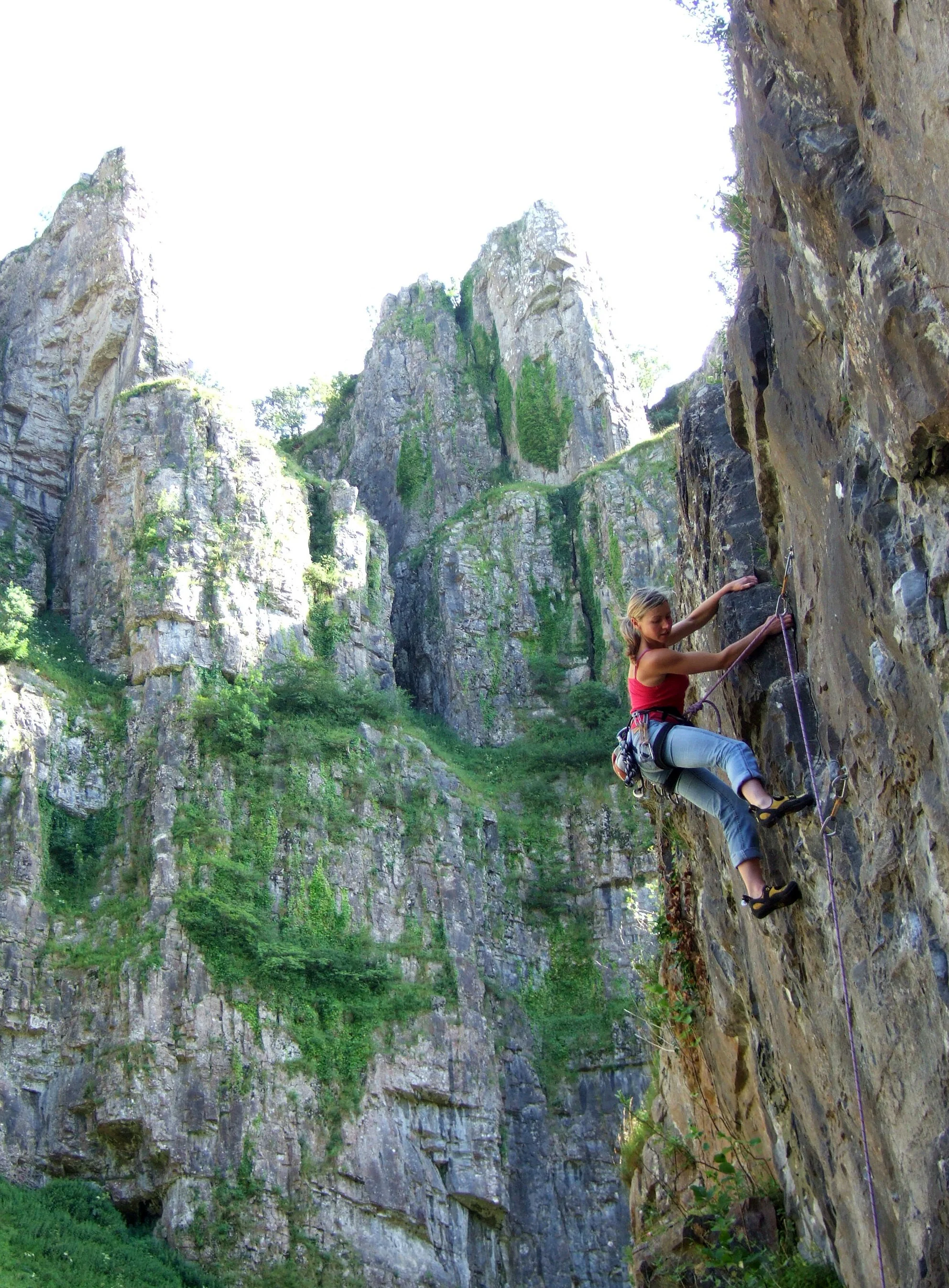
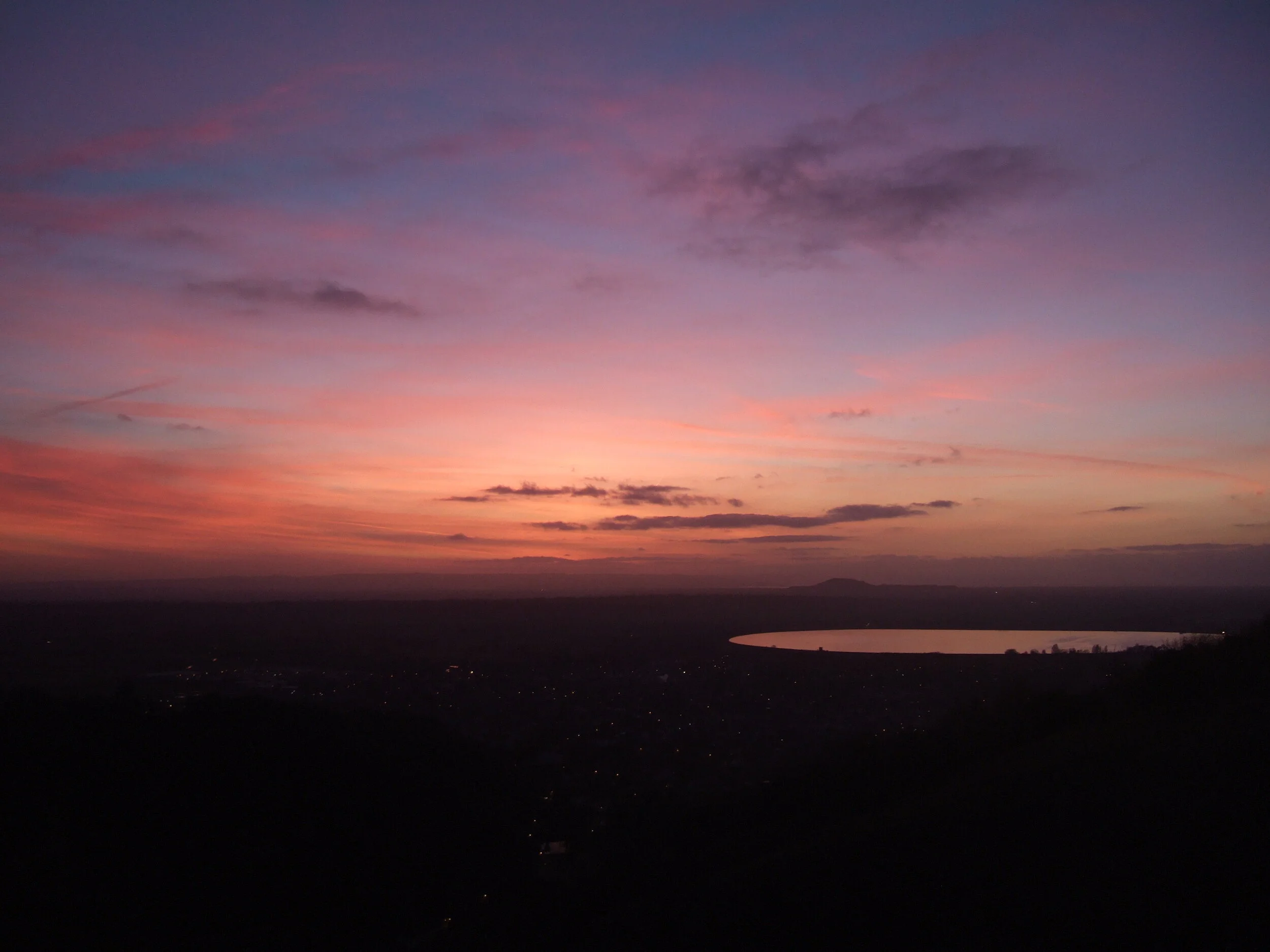
Cheddar Gorge
Top: Dan Jenkin on the final pitch of Castles Made of Sand (F6b/c), Pinnacle Bay, on the first ascent. Pic: Martin Crocker
“In order to maintain access in Cheddar Gorge, the most important thing for climbers to do is to take time to familiarise themselves with the terms of the climbing agreement before they visit.”
Rob Dyer, Access & Conservation Officer; British Mountaineering Council
Cheddar Gorge is one of the most important climbing sites in the south of Britain. A restoration project (2003 - 2006, 2009), which was coordinated with the wider conservation activities and plans of the landowners, has enabled many more climbs to become accessible when compared to the previously winter-only arrangements.
By British standards, the big routes here have considerable ‘wow factor!’, perching you amongst jackdaws 70…80…100 metres above the road. But Cheddar isn’t all exposed multi-pitch extremes; most people visit to climb on the smaller sociable roadside crags, which provide a range of sport and trad routes right through the grade range.
However Cheddar Gorge is possibly Britain’s most exacting place to climb from an access point of view. Hard-won climbing arrangements must adapt to public safety, conservation, and tourism issues. It is a Special Area of Conservation, a Site of Special Scientific Interest, contains six Scheduled Ancient Monuments, and lies within the Mendip Hills Area of Outstanding Natural Beauty. A commitment to ensure the safety of its many visitors using the road, car parks, and picnic spots is the key element that makes climbing possible here. Under no circumstances should third parties be subject to the threat of danger from rockfall caused by climbing. The access agreement is based on that principle, and a Code of Conduct is in place that should be followed by climbers.
Climbing Access in Cheddar Gorge
Having dedicated many years of my life to enabling improved climbing access in the gorge, I thought the best place to start would be to post a reminder about the terms of the agreement between landowners and climbers’ representative body, the British Mountaineering Council (BMC). So make yourself a big mug of tea, grab a tin of chocolate biscuits, and read on.
Since the agreement was first trialled there have been problems with small minorities of climbers not abiding by it, occasionally leaving access on a knife-edge, and everyone who cares about the place frustrated. As Rob Dyer indicates, problems almost always arise from not reading up what’s required before visiting. So, please take a half an hour to read on carefully and take any necessary action so you arrive at the gorge understanding the terms of the agreement and holding the necessary insurance. If you’re in any doubt, just get in touch with the BMC before visiting. I also recommend that on your first visit you take a walk around the gorge, guidebook and BMC access calendar to hand, and work out what’s what, including the agreed approaches to and from the crags. Cheddar Gorge is a complicated climbing site with many cliffs, and a day’s exploration on foot will be time well spent. What’s made it slightly more complicated still is that there have been a few provisional access improvements since the original agreement and the 2015 Cheddar Gorge Climbs guidebook. So, I’ve tried to make this section self-contained and up to date (April 2021).
“Cheddar Gorge & Caves recognises the importance of our cliffs for climbing. We welcome climbers but would ask them to respect the site, the Code of Conduct, and the climbing agreement we have with the BMC. This is not only really important from both public safety and conservation points of view but it will also help maintain the access climbers currently enjoy. Even during the temporary closure of our offices and attractions due to COVID-19, there will always be a management presence on site, and you can contact us direct or via the BMC. ”
Paul Ballantyne, Cheddar Gorge & Caves site manager
Please Take Time to Read the Access Information
The agreed climbing access arrangements are necessarily complicated and have the potential to be revised either way at any time. So please take time to read the introductory pages of the guidebook (reproduced here) and check the BMC’s Regional Access Database (RAD) before climbing in Cheddar Gorge. The calendar of dates when and where climbing is permitted is published annually by the BMC as the Cheddar Gorge Climbing Access Calendar, which should be downloaded from the BMC’s RAD – www.thebmc.co.uk (or from here). Make sure you have an up-to-date copy before a visit.
Cheddar Gorge Climbers’ Code of Conduct
The permission to climb in Cheddar Gorge is subject to climbers abiding by a Code of Conduct, which has been agreed (April 2005) with the landowner of the South Side, Cheddar Gorge & Caves, and that of the North Side, The National Trust. Download the full Code of Conduct.
Key Messages in the Code of Conduct
• Come prepared: know when and where you can climb before you arrive. And stick to the agreed ways on and off. Check the BMC’s Regional Access Database (RAD) on its website www.thebmc.co.uk before a visit. If in any doubt, contact the BMC by phone (0161 4456111).
• Think ‘public safety’ all the time. Climbing has the potential to harm innocent bystanders, particularly by dislodging rock or dropping kit. Please climb here with the utmost care and vigilance, and carry civil liability insurance.
• Think about your own safety too, including the ever-present risk of stonefall, especially when there is someone climbing above you. Wearing a helmet is strongly advised.
• If you see climbers doing something that they shouldn’t, let them know straight away.
• Members of the public will always be nearby or within earshot; please behave accordingly.
Cheddar Gorge & Caves (South) Side
The south side of the Gorge is privately owned by Longleat Enterprises Ltd, trading locally as Cheddar Gorge & Caves. There is no public right of access to the cliffs, but there is an agreement in place that permits conditional access for climbing to specific areas.
Up to 2006, climbing on the south side was permitted during the winter months only (1 October – 15 March). In 2006, as a result of the Cheddar Gorge Climbing Project, an agreement was made to extend (on a trial basis) the access period to a number of cliffs that had been cleaned and regeared, and which are sited behind rock-catch fences or otherwise relatively safely as far as any threat of rockfall into the road or car-parks is concerned. In partnership with Cheddar Gorge & Caves, the project was conceived and run by Martin Crocker with backing by the British Mountaineering Council (BMC). A review of the trials showed that it had proved a (qualified) success, and in 2009 new arrangements were agreed between Cheddar Gorge & Caves and the BMC. This agreement conditionally permits climbing to take place on specific climbs/cliffs most-of-the-year round, but excluding all the peak holiday and spring and summer Bank Holiday periods, when the gorge is at its busiest with people and cars. Further access additions, under trial since 2018/19, mean that some all-year-round climbing and all-year-round evening climbing on the south side is currently possible, as follows:
(a) Climbing can take place all-year-round after 6.00p.m. on a small number of roadside ‘most-of-year-round cliffs’, and
(b) Climbing can take place all-year-round on the restored climbs described in this guidebook in the upper (eastern end) of the Cheddar Gorge & Caves (South) Side.
The Access Agreement with Cheddar Gorge & Caves: What Is Required of Climbers
1 Who Can Climb Here: Requirement for Civil Liability Insurance
Climbing access is granted freely by Cheddar Gorge & Caves for not-for-profit recreational climbing on a volenti non fit injuria basis to climbers who are current members of the British Mountaineering Council (BMC) or Mountaineering Council of Scotland (MCofS), or members of their affiliated clubs, who thus have third party liability (civil liability) insurance against injury or damage to third parties or their property provided for them by the BMC/MCofS, and to those climbers who are not BMC/MCoS members but who have lodged their name, address, and a copy of their third party insurance with Cheddar Gorge & Caves at its office above Gough’s Cave. Volenti non fit injuria is a common law doctrine which states: ‘to a willing person, no injury is done’. Climbing is a dangerous sport willingly undertaken by climbers, and thus climbers are assumed to consent to the risk of being injured themselves while climbing. Climbers will be expected to be able to show proof of BMC/MCoS membership/affiliated membership.
2 When and Where You Can and Cannot Climb
The calendar of dates when and where climbing is permitted is published annually by the BMC as the Cheddar Gorge Climbing Access Calendar, which should be downloaded from the BMC’s Regional Access Database (RAD): www.thebmc.co.uk
The basis for the agreement is that climbing must not take place during peak visitor periods i.e.
• Easter Bank Holiday weekend
• May Bank Holiday weekend
• Spring Bank Holiday week including weekends either side
• The school and general summer holiday period covering the whole of July and August.
The above closures do not apply to (a) the restored climbs described in the Cheddar Gorge Climbs guidebook in the eastern end of the gorge, which can be climbed all-year-round; and (b) strictly only after 6.00 p.m., to the ‘most-of-year-round plus’ climbs (see 2c, below). These two easements are being trialled.
So, the described climbs (in the Cheddar Gorge Climbs guidebook) will fall into one of the following four access categories:
2a Winter climbs. You can climb the routes prefixed with ‘winter’ between the dates of 1 October – 15 March only. Each description is marked with WW .
2b Most-of-the-year-round climbs. You can climb the routes prefixed with ‘most-of-year-round access’ throughout the year apart from during the closed periods, the dates of which are published in the BMC’s Access Calendar following agreement with Cheddar Gorge & Caves.
2c Most-of-the-year-round plus climbs. You can climb the routes prefixed with ‘most-of-year-round access plus’ as for ‘most-of-year-round climbs’ but additionally with access being available after 6.00 p.m. throughout the year. This additional access is subject to a trial and review.
2d All-year-round climbs. You can climb the routes prefixed with ‘all-year-round access’ throughout the year. This additional access is subject to a trial and review.
A list of crags showing when they can be climbed on is reproduced as Appendix 2.
3 Cheddar Gorge Climbers’ Code of Conduct
Access for climbing is conditional upon climbers following the agreed Code of Conduct.
Civil Liability Insurance Cover
Anyone climbing on the south side of Cheddar Gorge must carry civil liability cover of at least £10 million. This comes as standard with BMC or MCofS membership but can be organized separately. BMC/MCofS membership cards or details of your individual policy must be carried as proof of cover while climbing on the south side of the gorge; the BMC climbing warden and Cheddar Gorge & Caves staff carry out frequent checks. Civil liability insurance is also recommended for anyone climbing on the north side of the gorge, but it is not a requirement.
BMC Cheddar Gorge Climbing Warden
The climbing access agreement is monitored by a climbing warden contracted by the BMC, an arrangement approved by the landowners. The warden promotes good practice and checks compliance with the agreed conditions. If you are climbing on the south side, please ensure you have to hand your BMC/MCoS membership card (or your civil liability policy if not a member). Reports of any issues found are made to the BMC.
BMC Regional Access Database (RAD) & Cheddar Gorge Climbing Access Calendar and Map
The calendar of dates of when and where climbing is permitted is published early each year and should be downloaded from the BMC’s Regional Access Database (RAD): www.thebmc.co.uk
The National Trust (North) Side
The north side of Cheddar Gorge is designated Access Land under the Countryside and Rights of Way Act 2000 (CRoW Act). Climbers have a legal right of access to this land including its cliffs all-year-round subject to the general limitations of the CRoW Act. However, on behalf of the British Mountaineering Council, local climbers have suggested that, on public safety grounds (risk of dislodging rock), access to a small number of cliffs be restricted to part of the year relative to the order of threat that climbing on them presents. These so-called ‘voluntary restrictions’ have been agreed between The National Trust and the British Mountaineering Council. Appendix 2 makes clear which north side crags represented here enjoy all-year-round access and which are restricted.
Commercial and Group Use
Use of the cliffs for commercial or business purposes, in employed (including self-employed) time, and by groups is restricted. Climbing access is prohibited to all ‘commercial users’, this means circumstances in which anyone involved either has to make a payment or is receiving a payment, including a wage or salary, for engaging in the activity. This restriction applies to all the cliffs in the gorge, on both Cheddar Gorge & Caves land and National Trust land.
Cheddar Gorge & Caves (South) Side
No person is allowed to climb anywhere on the South Side in summer or winter in pursuance of a business, or for personal profit or gain, or for educational, charitable, or publicity purposes, without Cheddar Gorge & Caves’s explicit prior permission in every instance.
The National Trust (North) Side
No person is allowed to climb anywhere on the North Side in summer or winter in pursuance of a business, or for personal profit or gain, or for educational, charitable, or publicity purposes, without The National Trust’s explicit prior permission in every instance.
Group Use (i.e. permitted groups like university clubs, large parties/families)
Please try not to monopolize whole crags, substantial parts of them, or routes. Use procedures that minimize wear and tear at the site, including to fixed gear (e.g. do not repeatedly lower off/top-rope directly through abseil rings, or abseil/top-rope direct around trees). Please make proportionate contributions to the area’s fixed gear fund. Follow the relevant MLTUK/BMC guidelines on the use of crags by groups.
New Climbs and Restoration Proposals
In light of the access negotiations, first ascensionists have had to ensure that they manage their new-routing activities very carefully. Both Cheddar Gorge & Caves and The National Trust require climbers to notify them of proposals for new routes or restoring old ones on their side before proceeding. The aim is to ensure that your plans are sensible and are not likely to cause, or have the effect of causing, any rock-safety issues or deleterious conservation effect. You will find both landowners highly appreciative of being contacted, and indeed they may be able to offer useful advice or assistance; telephone Cheddar Gorge & Caves on 01934 742343 (email: paul.ballantyne@cheddarcaves.co.uk) or The National Trust on 01934 844518.
Other Climbing in Cheddar Gorge
There is a vast number of routes not described in the Cheddar Gorge Climbs guidebook; they didn’t make the cut for public safety and qualitative reasons. If you can get a copy you can see them detailed in Avon and Cheddar (2004), The Climbers’ Club area guidebook, alongside the climbing history. Ultimately the descriptions will be made available on the author’s website: www.martincrockerclimbing.com (page to be developed, but low priority).
Cheddar Gorge Climbs (2015/2021)
This guidebook aims to provide easy-to-use topos and descriptions of the best and most widely accessible climbing in Cheddar Gorge. It also includes all the vital access information including the climbing agreement with Longleat Estates Ltd., the relevant appendices, and contextual documents. The 2021 edition was delayed by illness and COVID-19 effects (including the temporary closure of Cheddar Gorge & Caves offices). Despite these setbacks Cheddar Gorge Climbs (2021), which includes the updated access arrangements, has now been published. Copies can be obtained from three West Country retailers: Dick’s Climbing, The Gorge Outdoors, and Taunton Leisure.
Update
News has reached me of the recleaning in 2022 of some of the gorge’s best trad’ routes. A summary pdf is presented here.
Also I understand that ash dieback is causing a problem above Sunset Buttress, affecting the abseil descent from its summit. The following is copied from the BMC RAD. Sunset Buttress: the ash tree at the top of Space Tourist has ash dieback and is in poor condition. The strop for abseiling from has been removed and the tree marked with a cross. Do not abseil from it. All other ash trees along the buttress rim also have the disease and should not be abseiled from. There is one galvanised stake in place near the tree; however its provenance is unknown, but it was probably placed for rope access work. It will not have been tested for many years, and in addition it may be difficult to pull the ropes down from it. Until new abseil anchors can be set up, walking off and back down is advised.
Free Sample Topos
The BMC has suggested to me that I make available a few free topos of popular crags for climbers fresh out of the climbing wall who want to experience Cheddar Gorge climbing. In satisfying that request it must be noted that climbing in the gorge is unavoidably ‘burdened’ with an exceptional amount of access conditions, which makes a guidebook seem text heavy and, yes, heavy going to read. But there is no easy way round it: publishers including on-line platforms should use best endeavours to ensure all necessary access detail accompanies any routes’ information and that people are implored to read it. Otherwise, as occurs in Cheddar Gorge, a few guys turn up with only sketchy information and go on to make mistakes.
So, bear with me. I will make a few topos available on the understanding that (a) all the above is read and used in conjunction with the topo, and any action to ensure you comply with the conditions (e.g. obtaining civil liability insurance) is implemented before you climb; and (b) you make a donation to the area search and rescue team (ASSAR). Watch this space: there you go, the (three) topos are now available here.
Alternative Cheddar Gorge
I’ve put together a series of pics to illuminate some of the history of the development of the current access agreement and the consequential climbing events.

More Traffic-free Days in Cheddar Gorge?
Successive CragAttaK festivals of the late noughties illustrated the benefits of traffic-free days in Cheddar Gorge. Pedestrians, whether visitors or local residents, and climbers alike could enjoy a rare calm in gorge without fear of being run over. At the current time a proposal to institute regular traffic-free days in the gorge is being considered from the Mendip Hills National Landscape Team. If it becomes operational, Cliff Road (and therefore the gorge) will be closed to all vehicular through-traffic one day a month (probably on Sundays). Parking arrangements will be affected. Hopefully cyclists will be required to dismount or to manage their speed responsibly. You can keep up with the latest via the Mendip Hills AONB website www.mendiphills-nl.org.uk
Pic: Nigel Elliot testing the Omankowsky Tyrolean in anticipation of CragAttaK 2010

Cheddar Gorge Crag Tour
Take a walk around the main climbing areas of the gorge and see who’s hanging. This tour would take a lifetime if we stopped off at every cliff on-line. That time would be better spent walking around on site, checking out what’s what, the access arrangements, and the simple measures you need to take to be permitted to climb here. More details are available on the BMC’s website and in the Cheddar Gorge Climbs guidebook. All pics © Martin Crocker unless stated otherwise.

The North (National Trust) Side
It’s rare these days not to see anyone climbing on the north side of Cheddar Gorge. These small but convenient cliffs have exploded in popularity, thanks to the Cheddar Gorge Climbing Project and the goodwill and generosity of various climbing activists. Such is their accessibility that you could almost belay your mate from your car (please don’t!). They are particularly favoured by those after sport F5s/6s, of which there are many. For tougher action check out sublime testpieces on Lion Rock and The Remnant, but don’t forget the taste of trad and north side exposure on Heart Leaf Bluff – if you’re in the mood for a few frights.
Pic: The One-Armed Man (F6a). Rich Hobbs climbing.

Rave Party (F7a+), Heart Leaf Bluff. Rosea Day climbing.

Hug the Jug (F5/5+), Arch Rock. Buffy Furness-Smith climbing.

Valley of the Blind (F7b+/7c), Lion Rock. Adam Cooper climbing.

Simba (E1 5b), Lion Rock. Alexis Perry climbing.

Reservoir Walls and Top End
Above: Claire’s Complexity (E3). Dan Donovan climbing.
Beyond Shoot Gully, on the south side, lies a mixed bag of low cliffs, many right next to the road. On one hand is the odd, musty, and dank esoteria and, on the other, classics of both trad and sport genre. Pigs’ Hole is a favourite; but not to be forgotten are the many routes behind the covered reservoir currently described only in the Avon & Cheddar guidebook 2004. Variable safety considerations and evaluations have occasionally left a patchwork of access arrangements; always refer to the BMC RAD and BMC Cheddar Gorge Access Calendar and Map to find out the latest position here.

The Harder They Fall (E6 6b/F7b+). Johnny Woods climbing. Pic: Dave Pickford, www.davidpickford.com

Sorceress (E6 6b), Martin Crocker leading the first ascent, in 1985. Pic: Crocker coll. (Gordon Jenkin)

Pinnacle Bay
Above: Get That Man (F7a), Ginsberg Wall. Adam Mulholland climbing.
Pinnacle Bay is a vast and towering area towards the upper end of Cheddar Gorge. It hosts the roadside sport of Ginsberg and Yew Tree Walls, the single-pitch trad of Long Wall, and the epic100-metre adventures of the Pinnacle walls which are only permitted in the winter months. To get to the latter you have to tackle the slippery wastes of Shoot Gully and a hillside of nettles; or you could go get a cream tea instead.

Ambiguously Straightforward (F6b), Yew Tree Wall. Yvonne Jones climbing.

The Ides (E4 6a), Long Wall. Martin Crocker climbing. Pic: Carl Ryan

Brainbiter (E3 5c/E4 6b), Warlord Wall. Ian Parsons climbing.
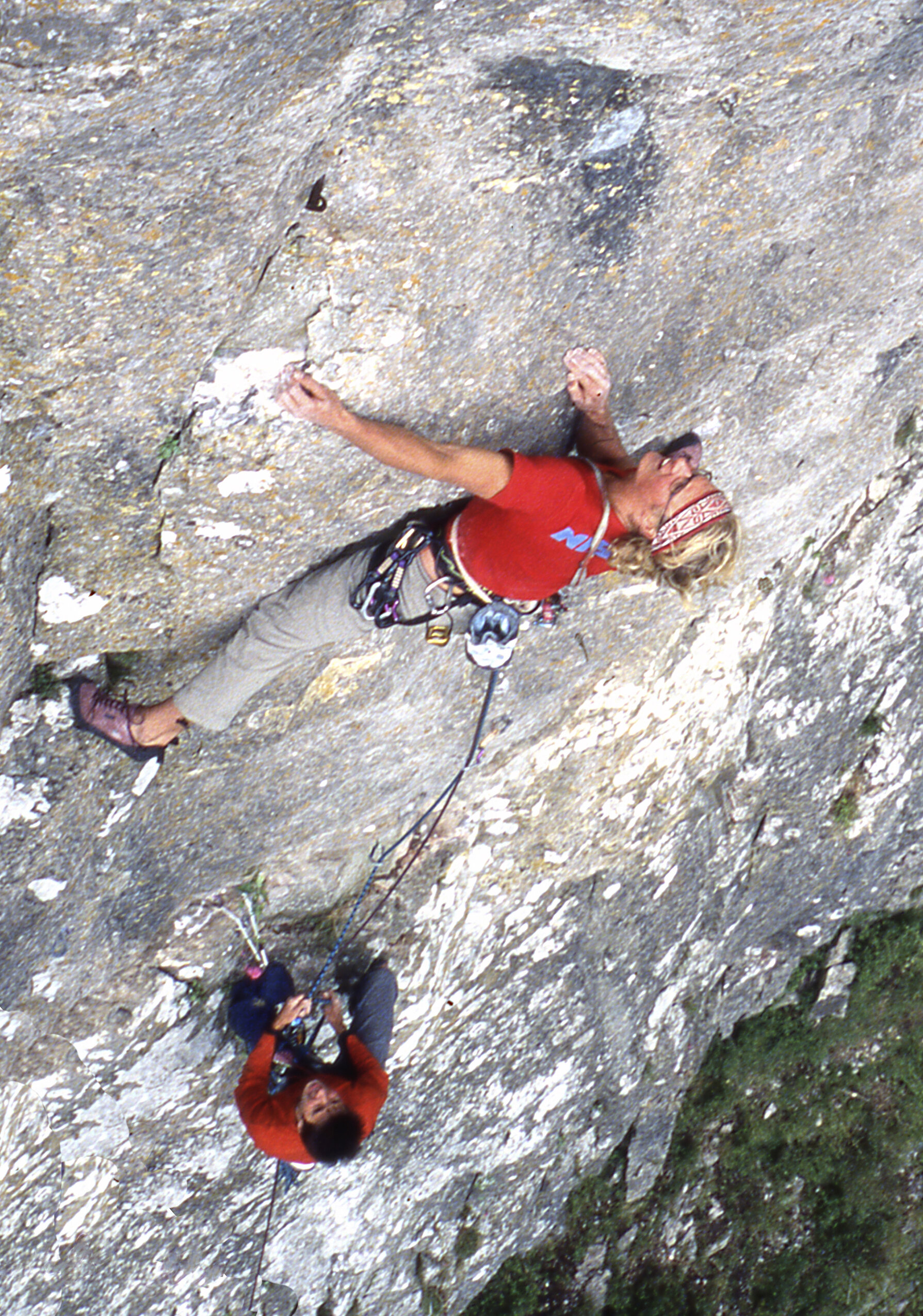
Doc Martin's (F7c), Warlord Wall. Dave Pickford (and Johnny Woods) climbing.

Castle Rocks (featuring Spacehunter Wall)
Above: Fornicator Simulator (F8a), Spacehunter Wall. Chris Scutt climbing.
Castle Rocks completes the serrated arc of Pinnacle Bay with three spectacular main walls. The best of these is the ‘skyscraping’ Spacehunter Wall, famed for its galaxy of three-star arm-blasters – a den of iniquity for the strong and those who can brave the exposed catwalk to get there. Elsewhere are much-coveted boulder problems and winter-only multi-pitch sport.

Siouxie (E5 6b/c), (see Avon & Cheddar guide 2004). Martin Crocker climbing. Pic: Matt Ward

Castles Made of Sand (F6b/6c), pitch 3. Gordon Jenkin climbing.

SkyScrape (F7b+). Ally Smith climbing. Pic: Dave Pickford, www.davidpickford.com

Tombstone (V9), Wallflower Shelter. Luke Hutcheson climbing.

Horseshoe Bend Buttress
Above: Partners in Crime (F6c+). Alex Jacubowski climbing.
Horseshoe Bend Buttress. For the wanna-be-seen; it’s busy and brash as cars screech around the infamous hairpin and chaff the sides of the narrows. This is the epicentre of Cheddar Gorge no less; and the climbing is so close to the road that you feel you could fall into the lap of a passing tourist. (At least that was the case when the Cheddar Gorge Tour Bus was running.) A great little wall with attractively graded sport routes overhung by the might of Sunset Buttress and serviced by a flask of coffee in your car. And a few of the north side crags are but a virtual pedestrian crossing away.

Crème de la Phlegm (F6c).

Partners in Crime (F6c+).

Sunset Buttress
Above: Paradise Lost (F7b). Jon Bentley and Julian Walker climbing.
Sunset Buttress is Cheddar’s world-class sport-climbing cliff, with unbeatable exposure. Here, hyperbolae rule unashamedly as young guns go wild in the country, quick on the draw. And as for the sub-F7 classic Space Tourist: well that’s ‘a big league multi-pitch sport route, the type you’d book a flight for.’ And amongst the Milton-inspired versions of Paradise, don’t forget Utopia a hallowed hark-back to the gorge’s trail-blazing in the 1960s.

The Midnight Run (F7c). Martin Crocker climbing (on the first ascent, 1989). Pic: Don Sargeant.

Bird of Paradise (F7b+). Martyn Richards (and Andy Sharp) climbing.

Space Tourist (F6b+). Ian Parsons climbing.

Pirates of Lamb Leer (F7a), Burmese Wall. Matt Ward (2nd) climbing.

High Rock
Above: Jack (VS 4c), with High Rock to the left and Acid Rock to the right. Jon Coutts climbing.
High Rock is king. A stratospheric precipice, featuring some of Britain’s longest and most celebrated inland outcrop climbs, including Coronation Street – a visitor attraction itself. All the multi-pitch routes are winter-only, but you can relax a little more on the lower wings which host a companionship between classic sport and trad in equal measure.

The Empire (E5 6a), The Amphitheatre. Alan Sarhan climbing.

West Route (E6 6a) (see Avon & Cheddar guide 2004). Gordon Jenkin climbing (1985 ascent).

Dig This, People (E4 6a). Martin Crocker climbing. Pic: Carl Ryan
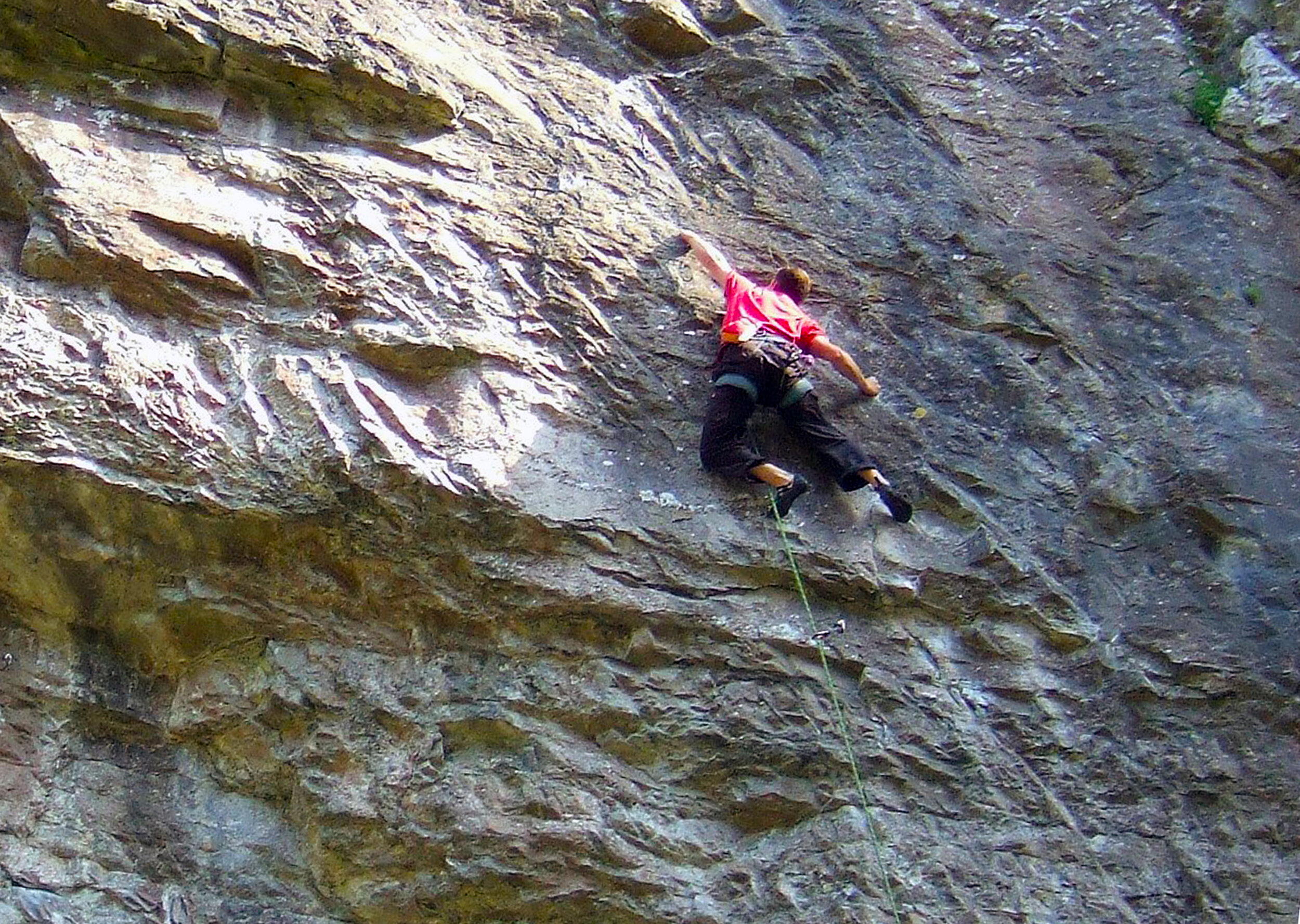
Still Waters Run Deep (F7b). Tom Harrison climbing.

Acid Rock
Above: Farewell to the Working Classes (F7a+). Rich Jenkin climbing.
Acid Rock refers to some 1960s activists’ proclivities. Perched on that perfect little stance in the middle of the main face you may think they had a point. Beautiful two-pitch trad here is matched by a range of top-calibre sport, all set in the afternoon sun and mind-blowing sunsets.

Shock of the New (F7b+), Freaky Wall. Paul Robertson climbing.

Neural Network (F6b), Sunnyside Terrace. Julian Walker climbing.

Above: Acid Rock trad perfection in Ahimsa (E3 5c). John Southworth climbing.
